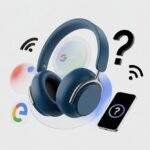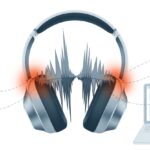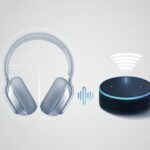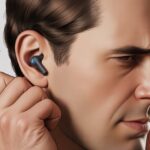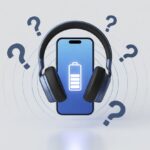We’ve all been there—ready to enjoy some high-res tunes, but our Bluetooth headphones just don’t want to play nice with LDAC. Most Bluetooth headphones skip LDAC because it needs special hardware and very specific software support on both the headphones and the device we’re pairing with.
Sometimes, it just doesn’t happen, no matter how many times we poke around in the settings menu.
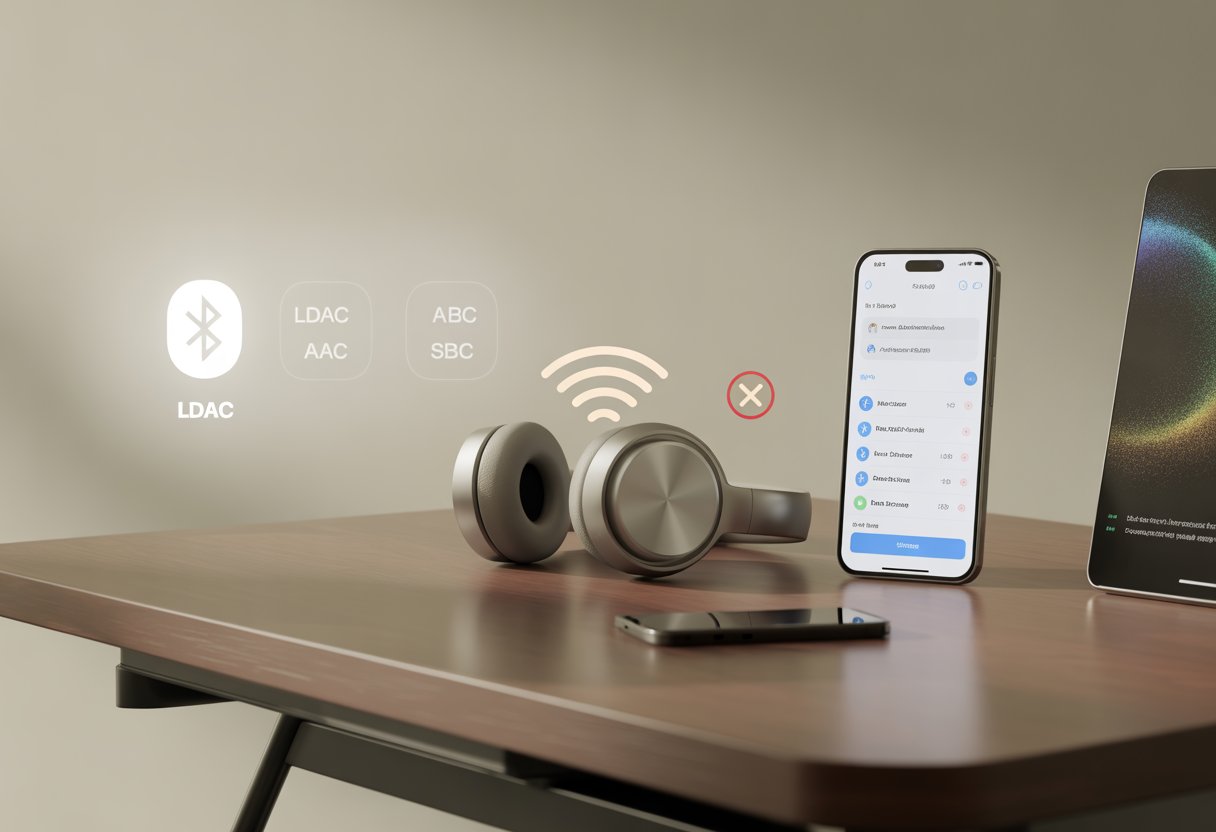
Honestly, we all wish our gadgets did everything perfectly. But manufacturers don’t always add every codec, and LDAC is a bit of a diva—it only works when everything matches up.
If we’ve been digging through menus and fiddling with apps and still can’t find LDAC, we’re not alone—lots of people get stumped by this.
But hey, don’t give up yet. Maybe our headphones missed the LDAC party invite, or maybe there’s a hidden setting somewhere.
Either way, let’s figure out why LDAC isn’t showing up for us!
What Is LDAC and Why Should You Care?
Bluetooth headphones don’t all play music the same way. The codec they use—the tech that handles sound—makes a big difference in what we actually hear.
Sometimes, the codec matters more than the price tag.
Understanding Bluetooth Audio Codecs
Bluetooth audio isn’t magic. It’s just a bunch of tiny data packets zipping through the air.
Every Bluetooth headphone uses a codec—basically a translator that squeezes our music into smaller bits so it can travel faster over Bluetooth.
The big names in codecs are SBC, AAC, aptX, and LDAC. SBC is everywhere, but the sound is just okay.
AAC works well on Apple stuff, while aptX is a favorite for Android. LDAC, Sony’s creation, tries to give us the best sound we can get over Bluetooth.
Here’s a quick table to keep it all straight:
| Codec | Common Use | Known For |
|---|---|---|
| SBC | Most headphones | Basic, reliable |
| AAC | Apple devices | Decent for music |
| aptX | Android devices | Clear, detailed |
| LDAC | High-end audio | High quality |
How LDAC Enhances Sound Quality
LDAC is like the top chef of Bluetooth codecs. It sends more audio data per second than the others, so our music sounds closer to the original.
LDAC handles audio up to 24-bit/96kHz, so we get richer sound and more detail in every track. That’s just a fancy way of saying we can hear our favorite song the way the artist probably wanted—even if we’re just doing chores.
But both our headphones and our phone need to support LDAC. If either one skips it, everything drops to a basic codec and we lose some of that sound quality.
Comparing LDAC with SBC, aptX, and AAC
Let’s break it down. SBC is the default and works with almost any Bluetooth device, but it can sound kind of flat.
AAC is great if we’re using iPhones—clean and crisp—but it’s not perfect on every Android phone.
aptX is a step up, cutting down on lag and making music clearer. And then there’s LDAC, which can send up to three times more data than SBC and handles high-resolution audio files.
Sony says LDAC keeps more musical detail, even over Bluetooth, which is pretty rare for wireless audio. You can read more in this Bluetooth audio codecs explanation.
But if our headphones don’t support LDAC, we’re stuck with the other codecs, even if our phone is ready for high-def. Sometimes, it’s just the headphones holding us back.
Bluetooth Headphones Compatibility: The Missing LDAC Mystery
Bluetooth headphones can seriously confuse us when a feature like LDAC is missing. Maybe it’s a licensing thing, a hardware issue, or just the phone we’re using—there are a few reasons why this fancy codec hides from us.
Licensing and Hardware Limitations
Not every headphone gets to use LDAC. Sony created this audio codec, and it doesn’t hand it out for free.
Manufacturers need a license from Sony to put it in their products, and those licenses aren’t always cheap or easy to get.
Hardware matters too. Some Bluetooth headphones, especially cheaper ones, just don’t have the right tech inside.
LDAC needs certain chips to handle high-res audio, so if the hardware isn’t there, LDAC won’t show up.
Even some expensive headphones might miss out if they weren’t built for LDAC. Before we blame our phones, it’s smart to check if the headphones can even do LDAC in the first place.
Supported Brands and Models (Spoiler: Not Just SONY!)
Sony made LDAC, but it’s not the only brand using it. Brands like Sony (think WH-1000XM5), Audio-Technica, and even some Jabra models now support LDAC.
Here’s the catch: we have to check the box or the manufacturer’s site, because sometimes even within a brand, some models skip LDAC.
Here’s a quick look at some brands and models that play nice with LDAC:
| Brand | Notable Models with LDAC |
|---|---|
| Sony | WH-1000XM5, WF-1000XM4, WH-H910N |
| Audio-Technica | ATH-ANC900BT, ATH-M50xBT2 |
| Edifier | W820NB, STAX Spirit S3 |
Sony has a bunch of options, but other brands offer LDAC as a bonus feature too. So don’t worry if your headphones aren’t Sony—just check before you buy.
Why Some Android Devices Support LDAC but iPhones Don’t
Android users get to enjoy LDAC on lots of devices, while iPhone fans are left out. This comes down to the Bluetooth choices each company makes.
Google added LDAC support in Android 8.0 and newer, so if our Android phone isn’t ancient, it probably works.
Apple, on the other hand, sticks with its AAC codec and just doesn’t bother with LDAC, no matter how much we want it. Even with the fanciest Bluetooth headphones, LDAC won’t show up on an iPhone.
If we really want LDAC, we need an Android device, LDAC-capable headphones, and maybe a little patience getting it all set up. For more details, check out why some Android devices support LDAC while iPhones do not.
Bluetooth Connection Matters: When Your Headphones Refuse to Speak LDAC
Sometimes, we get ready for amazing music, but all we hear is the same old standard sound. A few things can block LDAC from working, and they’re not always what we think.
Bluetooth Versions and Their Impact
Let’s be real—nobody brags about their Bluetooth version. But maybe we should.
LDAC needs decent speed and bandwidth. Devices with Bluetooth 4.0 or older almost never support LDAC.
This codec arrived with Bluetooth 4.2 and 5.0.
Bluetooth 5.0, 5.2, 5.3, and 5.4 bring better speeds, longer range, and more stable connections. LDAC can use up to 990 kbps, so old Bluetooth versions might drop the signal or just refuse to let us pick LDAC at all.
Newer gadgets handle LDAC more easily, so we get fewer dropped signals and less frustration. People using older headsets or phones might not see LDAC as an option.
The Role of DACs and Amplifiers
Even if our Bluetooth version is brand new, the hardware inside the headphones still matters. Every pair has a digital-to-analog converter (DAC) and a small amplifier.
LDAC sends a lot of digital info through the air. If our headphones’ DAC is too basic, it can’t handle LDAC, no matter how many times we try.
Cheaper headphones usually stick to basic codecs like SBC or AAC because their tiny DACs and amps can’t keep up with LDAC.
Table: Codec Support By Hardware
| Headphone Type | Typical DAC Support |
|---|---|
| Budget Models | SBC, AAC |
| Mid-range | SBC, AAC, AptX |
| Premium/Luxury | SBC, AAC, AptX, LDAC |
So if we’re missing LDAC, it might be all about what’s inside the headphones—not just the features on the box.
How Your Wireless Network Can Crash the LDAC Party
Most of us blame Bluetooth issues on distance or low batteries, but our wireless world is full of invisible chaos. Bluetooth and home Wi-Fi (especially on 2.4 GHz) battle for the same space.
If there’s a lot going on—someone’s streaming, gaming, and uploading all at once—the signal gets crowded. This digital traffic jam can mess with LDAC’s higher data rates.
We might notice sudden drops in quality or frequent disconnections. If LDAC keeps vanishing, try moving away from busy wireless spots or change Wi-Fi channels to avoid network interference.
Sometimes, our headphones just want a little peace and quiet. Can we blame them?
Tweaking Settings for Maximum Audio Bragging Rights
Let’s get into the wild world of Bluetooth settings, where a few taps can turn our headphones from average to awesome.
If we want hi-res audio, bragging rights start with knowing which settings to mess with and which numbers to chase.
Enabling LDAC in Bluetooth Settings
First, let’s check that both our headphones and device support LDAC. It sounds obvious, but it’s easy to miss—like trying to use a seesaw with only one side. To turn on LDAC, we usually dive into our device’s Bluetooth settings, find our headphones, and poke around for a gear or settings icon.
On many Android phones, we can flip LDAC on right in this menu. Look for something called “Audio codec” or “HD Audio: LDAC” and just switch it. If we use Sony headphones, the Sony Headphones app might ask us to pick “sound quality mode” first before LDAC even shows up.
If LDAC stays hidden, maybe our headphones, phone, or even the app is playing hard to get. Sometimes, only Developer Options lets us fully control things, so yeah, we might find ourselves nervously tapping around for “Bluetooth Audio Codec” settings.
Optimizing Transmission for Hi-Res Audio
Once we’ve got LDAC running, it’s time to get the most out of it. LDAC gives us three quality settings: Connection (330 kbps), Normal (660 kbps), and Quality (990 kbps).
If we’re after hi-res audio, we should just go for “Quality”—that’s the top bitrate LDAC offers.
Higher bitrates usually sound better, but they can be touchy about Bluetooth interference. If we hear dropouts or stutters while wandering around, switching down to 660 kbps can smooth things out.
For those of us who love tweaking settings, some phones let us pick these in Developer Options under “Bluetooth Audio LDAC Codec: Playback Quality.” The table usually looks like this:
| LDAC Setting | Maximum Bitrate | Best For |
|---|---|---|
| Connection | 330 kbps | Unstable Bluetooth, busy areas |
| Normal | 660 kbps | Good balance |
| Quality/Best Effort | 990 kbps | Best sound, short range |
Sample Rate and Bit Depth: Not Just Numbers
Let’s talk sample rate and bit depth for a sec. They sound intimidating, but honestly, they’re just numbers. Sample rate (like 44.1kHz or 96kHz) is how often our music gets “photographed” per second. Bit depth (16-bit, 24-bit) is how much detail each snapshot holds.
Bigger numbers usually mean nicer sound—if our devices can handle it.
Not every phone or headphone lets us mess with these, but if they do, we’ll probably find them in Developer Options. Cranking both settings to their max gives us that “hi-res audio” badge, though, let’s be real, only our dog might notice.
If we pick rates or depths our gear can’t handle, the audio just drops to something lower. Sometimes, mismatches cause stutters or weird robotic sounds, and nobody needs that in their playlist.
Technical Gobbledygook: LDAC Data Rates, Compression, and Audio Sorcery
LDAC sounds fancy, but really it’s just our headphones moving bits of music through the air as efficiently as possible. It’s all about packing, squeezing, and sending tunes at different speeds, with a few compromises lurking underneath.
Efficient Coding and Optimized Packetization
LDAC uses some smart coding to cram high-quality audio into Bluetooth’s narrow lane. It chops our music into small packets so everything fits and travels smoothly.
Imagine a team of movers loading a truck so nothing gets crushed—same idea.
Each packet tries to carry as much audio as possible without wasting space or causing hiccups. Optimized packetization helps LDAC cut down on drops and stutters, but our headphones have to keep up and decode fast. If they can’t, we get pops, crackles, or, ugh, awkward silence.
Lossless Audio vs. Compression: What’s the Catch?
Here’s the twist: LDAC isn’t actually lossless. It uses compression to shrink music files so they fit through Bluetooth’s tiny pipe.
That compression is “lossy,” so some detail gets tossed, but the idea is to lose only what our ears won’t miss.
We get three main bit rates (990, 660, or 330 kbps), and we trade audio quality for a steadier connection. If we want the highest quality, we’ll need a solid Bluetooth signal, or the phone might drop us to a lower setting to avoid skips.
True lossless audio keeps every detail, but LDAC makes a few sacrifices for wireless freedom. Still, it blows past regular Bluetooth codecs like SBC and AAC, as this Soundcore blog about LDAC explains.
Understanding Data Transfer and kbps
When we talk LDAC data transfer, it’s all about kbps—kilobits per second. That’s just how much audio data flies from our phone to our headphones every second.
LDAC tops out at 990 kbps, which is way more than the basic SBC codec. But to get that, everything needs to be just right.
Higher kbps means richer sound, but Bluetooth hiccups (walls, interference, old gear) can force us down to 660 or even 330 kbps. That cuts quality just to keep the music going.
As SoundGuys explains, stutters and drops can happen if the connection can’t handle those high rates.
So, yeah—higher kbps equals better sound, but only if the connection plays nice.
Alternatives to LDAC: When Life Gives You SBC
Sometimes our headphones just refuse to work with LDAC. That doesn’t mean we’re doomed to scratchy, sad sound.
There’s a whole buffet of other Bluetooth audio codecs, each with its own quirks and personality.
The Lowdown on aptX, aptX HD, aptX Adaptive, and aptX LL
If LDAC’s not happening, the aptX family steps in with its own flavors. The original aptX codec helps cut audio delay and usually sounds better than plain SBC.
It’s not as “hi-res” as LDAC, but it’s less picky about headphones (and our patience).
aptX HD bumps up the sound quality, supporting 24-bit audio. We’re still wireless, but it’s almost like CD instead of cassette.
aptX Adaptive is the cousin that tries to do everything—it changes quality and lag depending on what we’re doing, so games, movies, and music all get what they need.
For the impatient, there’s aptX LL (Low Latency), which is all about speed. Watching YouTube won’t feel like a bad dub anymore.
Here’s a quick table:
| Codec | Focus | Bitrate |
|---|---|---|
| aptX | Basic quality | ~352 kbps |
| aptX HD | Higher quality | ~576 kbps |
| aptX Adaptive | Flexible, low lag | 279-420 kbps |
| aptX LL | Ultra low latency | ~352 kbps, low lag |
AAC and Advanced Audio Coding Explained
AAC (Advanced Audio Coding) is the go-to codec in Apple’s world and works on Android too.
If we’ve ever used an iPhone or iPad, we’ve probably been listening through AAC.
AAC usually sounds decent, but only if our headphones and phone handle it well.
With Apple gear, AAC generally does a solid job. On some Androids, though, AAC can struggle—causing stutters or draining the battery.
AAC is harder for some devices to process, so sometimes it’s a toss-up if we’ll notice much difference from SBC.
Most music streaming services like Spotify and Apple Music use AAC, so it’s all around us. When it works, it’s better than SBC.
What Is LHDC and Should You Care?
LHDC (Low Latency High-Definition Audio Codec) is another option for filling the LDAC-shaped hole in our hearts.
It promises high-res sound over Bluetooth and shows up on some Android devices, especially from Asian brands and in certain music apps.
Like LDAC, LHDC can push higher bitrates, so we get more audio data to our ears. If we’re all about “hi-res” and both our headphones and phone support it, LHDC can be a solid substitute.
The catch? LHDC support isn’t as common as SBC or aptX, so we might have to do some digging to see if our gear has it.
For those who care about every musical detail, it’s worth checking for LHDC support.
Subband Codec (SBC): Blessing or Necessary Evil?
Let’s be honest, SBC is the “universal adaptor” of Bluetooth audio. Every Bluetooth audio device supports Subband Codec (SBC) because it’s required.
It splits music into subbands, squeezes everything down, and sends it through the air.
Is SBC good? Well, it does the job. It won’t blow anyone away, but it rarely lets us down.
Think of SBC as the instant noodles of audio codecs—not fancy, but surprisingly okay when expectations are low.
We can always count on SBC to work, and while the audio quality isn’t mind-blowing, it gets us through commutes, walks, and awkward gym moments.
So, even if we roll our eyes at SBC, it’s the dependable sidekick we didn’t know we needed.
Audio Files, Transmission, and Psychoacoustics: The Wild World of Streaming
We love to imagine our music sounds just like the studio version, but a lot happens between pressing play and hearing Billie Eilish in our ears.
Our files, Bluetooth connection, and even our brains all mess with sound quality in weird ways.
How Audio File Formats Impact Bluetooth Streaming
Let’s say we’re streaming music and our phone has a FLAC file—a fancy, lossless audio file. Bluetooth headphones have to deal with all kinds of files, from high-quality FLACs to humble MP3s.
Most Bluetooth codecs, like LDAC or AAC, don’t send these files as-is. The original audio gets compressed again just to fit through Bluetooth’s tiny pipe.
This double-compression can lose some quality, especially if we started with a low-bitrate MP3. Even if we splurge on premium streaming, our Bluetooth audio might never match what a solid pair of wired headphones delivers.
If you want more on how codecs change audio during streaming, check out this overview of Bluetooth codecs.
Down-Conversion and Its Effects on Sound
Now for the fine print: down-conversion is the sneaky process that shrinks our high-res files to fit through Bluetooth’s limits.
It drops the bitrate, sometimes taking a 24-bit, 96kHz WAV file and turning it into something much smaller.
Here’s what usually happens:
| Original File | After Down-Conversion | Result |
|---|---|---|
| FLAC (lossless) | SBC/AAC/LDAC* (lossy) | Lower dynamic range |
| WAV (hi-res) | SBC/AAC (lossy) | Possible audio artifacts |
| MP3 (low bitrate) | SBC/AAC/LDAC (lossy) | Even lower sound quality |
So, even if we buy fancy headphones, Bluetooth audio can only carry so much detail. We need a codec like LDAC to get close to hi-res sound, but even that isn’t totally lossless.
Psychoacoustics: Why Our Brains Think 128 kbps is a Symphony
Here’s the wild thing: our brains just don’t always notice what’s missing. Psychoacoustics digs into how we actually hear sound, and it’s a little mind-bending.
That’s how a 128 kbps MP3 sometimes fools us into thinking it sounds amazing—until we throw it on some legit speakers and realize, hmm, something’s off.
Compression works by slicing out audio bits we supposedly can’t hear—stuff way up high or buried down low. Most of the time, we’re too busy belting out the lyrics to care, unless we’re really paying attention or listening on something better than basic earbuds.
Audio engineers kind of rely on us not catching those missing pieces. With the magic of psychoacoustic modeling, they usually get away with it.
When in Doubt: Testing and Troubleshooting Your LDAC Settings
Let’s try to crack the code on those moody Bluetooth headphones. We’ll hunt down whether our devices support LDAC, dodge annoying lag, and see if we can coax our headphones into sounding their best.
Compatible Devices and How to Spot Them
First off, we’ve gotta check if our headphones and devices actually do LDAC. Not every Bluetooth headphone is up for the job—some just pretend.
If LDAC appears in the specs, we’re good. Sometimes it hides in the settings, but usually, we find it on the manufacturer’s website or in the manual.
For phones and laptops, we can poke around in Bluetooth settings or developer options to see if LDAC pops up as a codec. On Android, turning on developer mode lets us pick codecs for whatever’s connected—if LDAC’s missing, there’s our first clue.
Apps like Sony’s Headphones Connect can also tell us if we’re running LDAC or stuck with something else. If you’re not sure what your device can do, this how to check LDAC support tip is pretty handy.
Dealing with Latency and Low Energy Bluetooth
LDAC loves speed and chews through data. When we use it, latency can sneak in.
If we spot lip sync issues or lag while watching videos, cranking up the quality might be the culprit. LDAC doesn’t really care about being super fast—it’s all about sound quality.
Bluetooth Low Energy (BLE) throws another curveball. BLE’s built for simple stuff like fitness bands, not high-bitrate audio.
If our headphones or device only support BLE audio, LDAC won’t work. LDAC needs regular “classic Bluetooth,” so we should avoid pairing through BLE.
For lower latency, we might try codecs like aptX Low Latency, but they won’t reach LDAC’s sound quality.
What to Do If Your Headphones Still Won’t Play LDAC
If our headphones keep refusing, it’s time to get serious with troubleshooting. First, let’s check for updates on both devices—software bugs sometimes block codecs.
Head into Bluetooth settings, tap the gear next to our headphones, and see if we can turn on LDAC. If LDAC’s missing, try repairing, restarting, or using the manufacturer’s app.
Sometimes LDAC only kicks in when we pick a “quality over connection” mode in the app—Sony’s Headphones Connect does this. If we’re still stuck, this Bluetooth LDAC troubleshooting guide might help.
Oh, and don’t forget—walls, microwaves, and even cranky neighbors can mess with LDAC. For the best sound, keep devices close and avoid Bluetooth’s “danger zone.”
If LDAC still refuses, at least we’ve earned some serious Bluetooth troubleshooting chops.
Audiophile Extras: Can LDAC Deliver TRUE High-Resolution Audio?
Let’s poke around the world of high-res audio and see if LDAC can actually deliver. There’s more going on than just flicking a switch—our music source, the gear inside, and even the drivers matter.
TIDAL, Trials, and Chasing High-End Audio
If we’re chasing “TRUE” high-res audio, we can’t just stream random pop hits and expect miracles. Services like TIDAL say they offer lossless tracks, and some audiophiles keep swapping subscriptions or files, hoping to catch every tiny detail.
Here’s the thing—LDAC is definitely a step up from basic Bluetooth codecs, but it can’t give us bit-perfect high-resolution audio like a good old cable. It supports up to 32-bit/96kHz data, but Bluetooth squeezes the file, so we lose a bit along the way.
If you’ve got superhuman hearing, maybe you’ll notice. But in real life, background noise, compression, and our phones chip away at those dream moments.
For most of us, LDAC sounds great—it just isn’t flawless.
Digital to Analog Converter (DAC): The Unsung Hero
The Digital to Analog Converter (DAC) inside our headphones or phones turns digital files into signals we can actually hear. No matter how fancy the codec, a weak DAC will flatten the music.
Even when we stream high-res tracks over LDAC, the DAC has to keep up. If our phone or headphones have a basic DAC, all that detail from TIDAL just gets lost.
It’s kind of like pouring expensive soda into a flimsy paper cup—something’s just off.
High-end headphones usually have stronger DACs, which unlock more of what LDAC and high-res streaming can offer. But if the DAC is weak, no fancy codec or streaming service can save the sound.
Audio Drivers and Your Headphone’s Secret Sauce
Drivers are basically the tiny “speakers” tucked inside your headphones. They shape whether music sounds crisp or just kind of muddy.
Some headphones throw in big dynamic drivers for thumping bass. Others stick with balanced armature drivers, chasing those clear, sparkly highs.
You can have the fanciest DAC and the best codec out there, but if the drivers don’t deliver, none of it really matters. Great drivers pull out the little details in a high-res track. Bad ones? Everything just sort of blends together—even if you’ve got LDAC running as fast as it can.
Trying to get LDAC support, a solid DAC, and killer drivers all in one pair of headphones feels a bit like building a burger with all the toppings. If you’re missing one, you’re just eating plain bread—no matter how much the marketing hypes it up.
- How to connect Bluetooth headphones to a Chromebook Without Summoning Tech Support - December 15, 2025
- Best Fitness Trackers for EMS Workers: Because Your Heart Rate Isn’t the Only Thing Racing - December 15, 2025
- Why do my Bluetooth headphones not skip tracks? Tech tantrums and other musical mysteries - December 14, 2025

